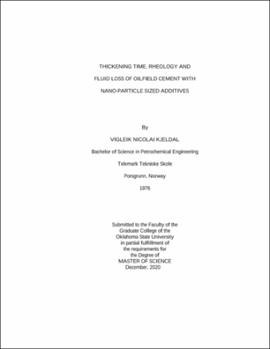| dc.description.abstract | Cementing around the casing in oil and gas wells provides proper zonal isolation, holds the casing in place, and prevent fluid migration is an important part of the completing process, and well plugging for abandonment. By adding different nanoparticles (NPs) additives of barite or magnetite to heavy cement and bentonite to light cement, we seek to create the perfect cement sheet. This thesis study shows how adding NPs influences cement fluid properties such as thickening time, fluid loss, and rheology. A heavy control case cement formulation using Portland cement class H, barite, hydroxyethyl cellulose (HEC), boric acid, and seawater, was modified with three different concentrations for 1, 3, and 5 % by weight of cement (BWOC) of barite or magnetite NPs. A light control case cement formulation using Portland cement class A, bentonite, HEC and, seawater, was then modified with three different concentrations for 1, 3, and 5 % (BWOC) of bentonite NPs. A consistometer was used to find the cement thickening time, a high-pressure high-temperature (HPHT) fluid loss tester was used to study the cement slurry filtration and a viscometer apparatus was used to find the rheology properties, just after the cement placement. Thickening time and fluid loss were measured at high pressure and high temperature for heavy cement and high pressure and low temperature for light cement. The thickening time increased for all concentrations of NPs, except for the 5% BWOC magnetite NPs. Rheology properties were measured at low pressure and high temperature for heavy cement and low pressure and low temperature for light cement. The shear stress of the heavy cement increased for all concentrations of NPs, while there was an insignificant change for the light cement. Plastic viscosity decreased for all concentrations of NPs, except 1% BWOC magnetite NPs. For all types of NPs, it was observed that fluid loss generally decreased by increasing NP concentrations for both heavy and light cement. | |
